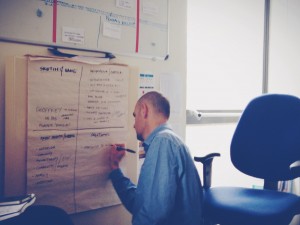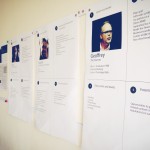The webdev team is just starting to develop a new University news system.
Following our user-centered design principles, we’re spending a few days going through a process of discovery.
In this post I’m focussing on how we built personas to help us get a handle on who our key users are.

Yes, I know ideally this would be a few weeks, not days. But a lot of the groundwork for the project – business cases, high-level project plans, and some preliminary user testing – have already been done.
Right now we need to figure out things like:
- who are the target consumers of news?
- who will be editing news stories?
- how will editors create news stories?
- is there any workflow around creating news stories?
- how will people find UniKent news?
- how will we measure if our news system has been successful?
- what is the vision of the news team? What do they want to achieve with a news site?
To help us answer all these questions Katie – one of the University Press Officers – has come over to our offices for this sprint to work directly with us. We also have Etienne from Corporate Comms coming over and helping out when he’s able to.
It’s great that they’ve been given so much time to work with us in an Agile way. After just two days here we’ve learnt so much about their target audiences and how the press team works.
In a traditional waterfall model, we’d probably have had half a dozen meetings spread out over two months, and still be none the wiser.
We cannot emphasise enough how having our customer work with us so closely is something that other teams should consider doing too.
We’re also getting in a few other news editors from around the University. These are the people who will actually be using the system to write news stories. So it’s vitally important that we work out what their needs are.
Who are our users?
Finding out who users are can seem daunting, particularly for a news system.
“Anyone and and everyone” might be your first try. Not so very helpful.
What you need to do is distill a range of target users that your customer (for us our Corporate Comms team) is aiming at.
And to answer that you really need to ask your customer why they even want the service in the first place.
Is it primarily a marketing tool? Is it to build a sense of community? Is it to help share knowledge? There might be all sorts of business needs.
We found focussing on three core needs is a great first step:
- recruitment
- furthering research
- furthering reputation
- first level personas
- personas after they’ve been tidied up a bit
With Katie and Etienne’s help we then built persona categories around these: Prospective students and their parents:
- Helen, a 17 year-old thinking about studying at Kent.
- Judith, a 43 year-old parent whose child is currently choosing universities.
- Liu, 29 year-old prospective postgraduate from Shanghai.
Staff/current students:
- Ryan, a 20-year old current undergraduate.
Alumni:
- Geoffrey. 48 and in finance.
People from the local community:
- Joyce. 52, self-employed and living close to the University.
We also had a separate category for users of the editing system itself. News publishers:
- Louise. 30 and responsibly for marketing in a University department.
- Sam. 27 and a Press Officer in the Corporate Comms team.
Next steps
So we have our personas. Next we’re looking at working out the stats and user journeys on the existing news site. And then looking at what the business needs are in terms of improving on this and shifting those user journeys.
For example, we found that the existing news pages don’t get as much traffic as we’d like. Why is that? How can we get our users from the homepage to the news pages?
After that we can start to build high-level user stories from our persona users’ needs. For example, “As Joyce I would like more newsletters so that I can keep up with what’s going on without visiting the website“.
These user stories will form the basis of our alpha and beta phases, with the higher-level stores being broken down into more specific stories, and ultimately developer tasks.

